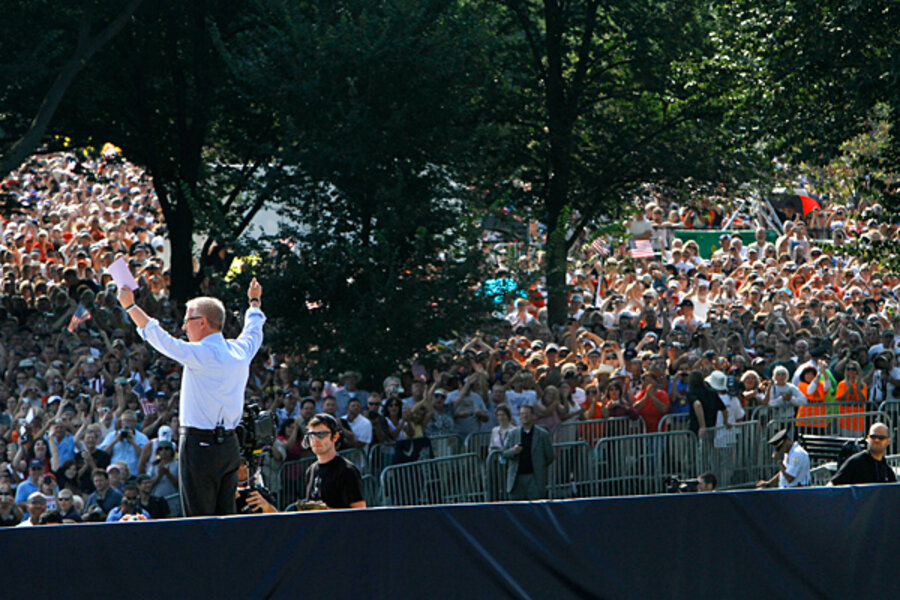Will the Beck and Colbert-Stewart rallies rock the vote?
| Los Angeles
At a time when many voters are rebelling against traditional political-party labels, it is no coincidence, say media and political experts, that the most talked-about rallies in Washington during this election season are the work of three talk show hosts.
First, there was the Aug. 28 rally on the steps of the Lincoln Memorial, fronted by Fox's Glenn Beck. Coming up on Oct. 30 will be the other, a double-header bash before the Nov. 2 election: Comedy Central's Jon Stewart and Stephen Colbert are putting on the Rally to Restore Sanity and/or Fear on the National Mall.
More and more, the average voter views the mainstream political system as “broken,” says Geoffrey Baym, author of “From Cronkite to Colbert: The Evolution of Broadcast News.” Americans across the ideological spectrum are turning to what they consider “outsider voices to articulate their concerns.” Increasingly, those contrarians are on television and radio talk shows, he adds.
The role of TV talk shows in today's elections cannot be overestimated, says former Republican speechwriter Curt Smith, who is now a senior lecturer at the University of Rochester in New York. “The TV talk show, for better or worse, has become the picture window through which Americans view elections,” he says. It “surveys and critiques, celebrates and condemns, depending on the ideology of the show.”
On the liberal end of the talk show spectrum, Mr. Colbert and Mr. Stewart play serious issues for laughs, he notes. Meanwhile, MSNBC - with Keith Olbermann and Rachel Maddow - goes more for straight talk.
Yet the combined audiences of the programs with a liberal tilt “are nothing compared to the audience numbers for the conservative-leaning ones, in particular Fox News,” Mr. Smith says. The consensus about these shows has been that they largely preach to the choir, making few converts, he says. But that is changing with their continued growth, especially at Fox, he adds.
On the conservative side of the equation, he says, “TV and radio talk shows are no longer a supplement for the Republican Party; they have become a substitute for the Republican Party.”
The GOP hierarchy, Smith says, is seen by many in Middle America as “gutless, duplicitous, and contemptuous of most people who would be Republicans.” Tea party activism has little affiliation with the Republican Party, he notes, adding that the movement’s informal leaders instead are rising from the airwaves. In fact, he says, four of the conservative figures most talked about for the 2012 presidential election are on the Fox News payroll: Sarah Palin, Mike Huckabee, Rick Santorum, and Newt Gingrich.
As Fox has gotten more attention, other talk show hosts are responding. The double Comedy Central rally was launched in response to a groundswell of fan demand for a satiric counterweight to the earlier Glenn Beck event. That August gathering drew many tea partyers to the nation’s capital and received widespread coverage.
This is all happening at a time when both broadcast and cable TV channels are in a battle for audiences - particularly younger viewers who increasingly get their news from the Internet and mobile devices.
The trend among the under-35 cohort to turn to comedy for news has helped drive the popularity of programming such as Stewart’s “The Daily Show.” New media is helping these comics, says communications specialist Jonathan Askin, an associate professor at Brooklyn Law School in New York.
“Comedic analysts now have much more extensive and direct access to the people via multiple media outlets,” he says, including viral online distribution. As a result, "the most insightful comedic pundits – Jon Stewart and Stephen Colbert among them - have a newfound opportunity for direct and immediate engagement.”
But even if Stewart's event hits its jokingly stated goal of a “million moderate march,” its impact will be difficult to gauge. More specifically, it remains to be seen whether these rallies play out as merely entertainment or as a spark for longer-term activism.
Turnout at the polls Nov. 2 will probably not be a good guide. That’s because midterm elections tend to revolve around local issues, and figures like Colbert and Stewart do little with gubernatorial and state initiatives, says Ed Crego, coauthor of “Renewing the American Dream: A Citizen’s Guide for Restoring Our Competitive Advantage.” Also, the 45-and-under crowd tends to vote less in the nonpresidential years, he points out.
With these points in mind, Mr. Crego says, the real effect of the rally will not be felt until the next presidential election. “The impact of this mobilization is really for 2012,” he says.
Making a similar point is Ari Berman, a political writer for The Nation and author of “Herding Donkeys: The Fight to Rebuild the Democratic Party and Reshape American Politics.” Whether or not one agrees with the tactics or politics of various talk shows, he says, they all are becoming launchpads for participation and issues.
The Oct. 30 rally may not support a candidate, but for some participants, says Mr. Berman, they are the first step toward saying, “I care.” Especially for the Democrats, who have seen their support slide, that could be a welcome development.





